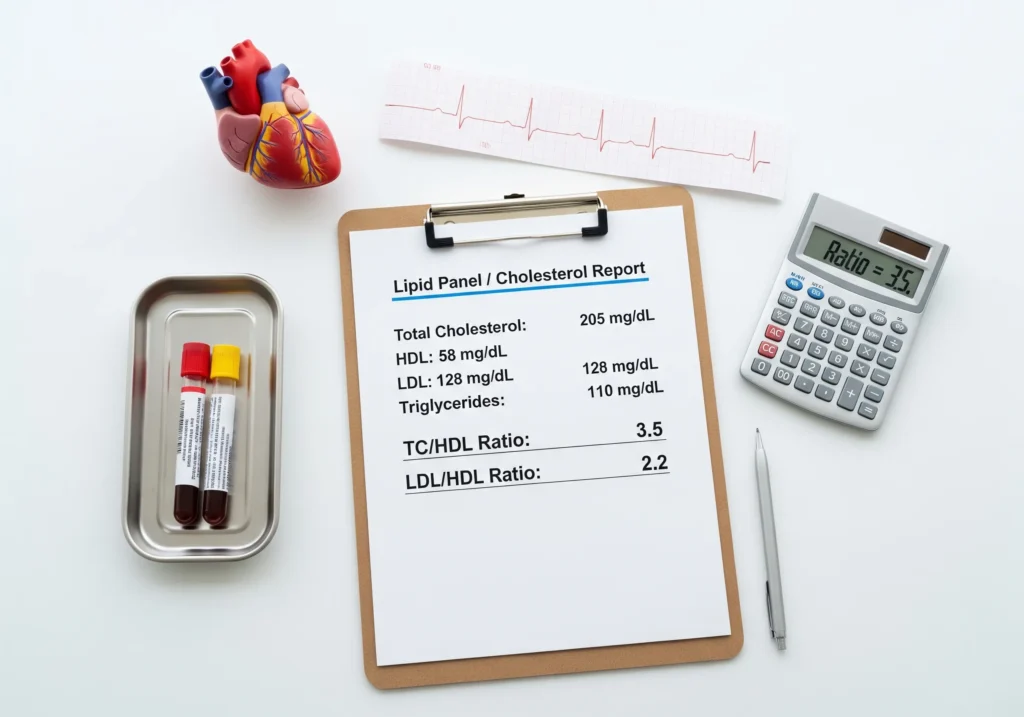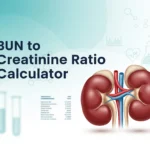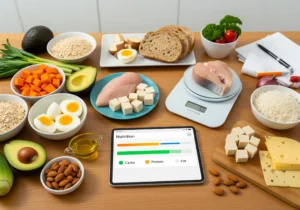Cholesterol Ratio Calculator | Understand Your Heart Health Risk

Calculate Your Ratio
Enter your cholesterol values to assess your heart health risk
Understanding Your Cholesterol Ratio: A Simple Guide to Heart Health
You’ve got your cholesterol numbers, but what do they really mean for your heart? Staring at “Total Cholesterol” and “HDL” can be confusing. That’s where the Cholesterol Ratio comes in. It’s a simple, powerful tool that gives you a clearer picture of your heart health risk.
What is the Cholesterol Ratio?
Think of your arteries as highways. Cholesterol is like the cars on that highway.
- Total Cholesterol: This is all the cars on the road. Some are good, some are not so good. A high number here can mean there’s a lot of traffic.
- HDL (High-Density Lipoprotein): This is your “good” cholesterol. Think of HDL as the “garbage trucks” or “tow trucks” of your bloodstream. Their job is to travel around, pick up the bad cholesterol, and clear it out of your arteries, preventing traffic jams and blockages.
The Cholesterol Ratio doesn’t just look at the total traffic; it looks at how many garbage trucks you have to manage that traffic. A good ratio means you have plenty of HDL “garbage trucks” to keep your arteries clear, even if your total traffic is a bit high.
How Our Calculator Works (Step-by-Step)
This tool is designed to be incredibly simple. Here’s exactly what happens when you use it:
- You Enter Your Numbers: You’ll need two numbers from a recent blood test (lipid panel).
- Total Cholesterol (mg/dL): You type this number into the first box. This is the overall amount of cholesterol in your blood.
- HDL Cholesterol (mg/dL): You type your “good” cholesterol number into the second box.
- You Click “Calculate”: When you hit the button, the calculator performs one simple math problem.
- The Magic Behind the Scenes (The Formula): The calculator uses this universally accepted formula:
Your Cholesterol Ratio = Total Cholesterol ÷ HDL Cholesterol - You Get a Clear Result: The calculator then compares your result to the standard medical guidelines to place you in one of three categories:
- Low Risk (≤ 3.5): This is fantastic! It means you have a healthy balance and a lower-than-average risk for heart disease.
- Moderate Risk (3.5 – 5): This is the average range for many people. It’s not a red flag, but it is a “yellow light”—a sign that making some positive lifestyle changes could be very beneficial.
- High Risk (> 5): This number is a call to action. It suggests you have a higher risk of developing plaque in your arteries and should definitely discuss the result with your doctor to create a plan.
Example:
If your Total Cholesterol is 200 mg/dL and your HDL is 60 mg/dL.
The formula is: 200 ÷ 60 = 3.33.
The calculator would show your result as Low Risk.
Why is This Ratio So Important?
For many years, doctors looked primarily at Total Cholesterol. We now know that’s only half the story. The ratio is often a better predictor of heart disease risk for a simple reason:
- It provides context. A person with a high Total Cholesterol of 240 but a very high HDL of 80 has a ratio of 3.0 (Low Risk). They have a lot of “garbage trucks” keeping things clean.
- Conversely, someone with a “good” Total Cholesterol of 180 but a very low HDL of 30 has a ratio of 6.0 (High Risk). They don’t have enough “clean-up crew,” so that cholesterol is more likely to cause problems.
This simple number helps you and your doctor quickly assess your risk and decide on the best next steps.
Beyond the Ratio: What Your Doctor Also Looks At
This calculator is an excellent starting point, but it’s one piece of a bigger puzzle. Remember, we don’t treat numbers; we treat people. A complete heart health assessment also includes:
- LDL (“Bad”) Cholesterol: The cholesterol that HDL helps remove.
- Triglycerides: Another type of fat in your blood.
- Your Personal Factors: Your age, blood pressure, family history, diet, activity level, and whether you smoke or have diabetes are all critically important.
The Golden Rule: Use this calculator as a tool to become more informed, not as a diagnosis. Always discuss your results with your healthcare provider.
Frequently Asked Questions
- Regular Exercise: Aerobic activity (brisk walking, swimming, cycling) is great for boosting HDL.
- Healthy Fats: Eat more unsaturated fats found in avocados, olive oil, and nuts.
- Omega-3s: Fatty fish like salmon and tuna are excellent sources.
- High-Fiber Foods: Oats, beans, and apples can help lower bad cholesterol.
- Quitting Smoking: This is one of the single best things you can do for your HDL levels.
- Limiting Trans Fats: Avoid foods with “partially hydrogenated oils” on the label.
Popular Calculators

Cooking Measurement Converter – Cups, Ounces, Milliliters, Grams & More

Hourly to Salary Converter – Calculate Annual Income

Corrected Calcium Calculator | Accurate Serum Calcium Interpretation

BUN to Creatinine Ratio Calculator | Assess Kidney Function

Fraction to Decimal Converter


